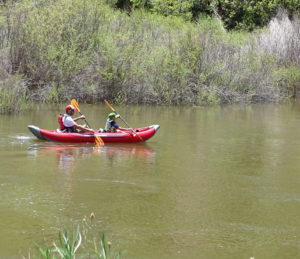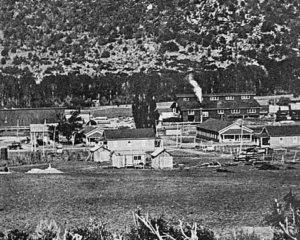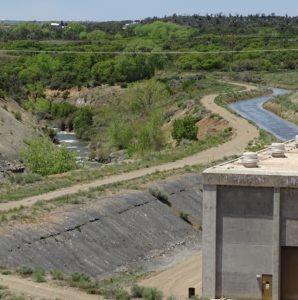Like sands into an hourglass, the San Juan Mountains snow pack has been flowing into the Dolores River and filling the McPhee Reservoir in southwestern Colorado.

A mural in Dolores
For weeks, the boating community has been watching the granular increases (posted online by the Dolores Water Conservancy District) and waiting with collective breath for the reservoir to reach its 381,000 acre foot capacity or an elevation of 6,924 feet.
It fills. It spills.
For the first time in five years, the DWCD has announced a “spill” or managed release, beginning June 3 and lasting for three days. Rapids from Class I to Class V will return to what some have called one of the most iconic stretches of American river. Read more release information here.
“The way it’s managed now, you really have to drop everything and go,” said Jane Dally, a board member of the Dolores River Boating Advocates.

Boaters above McPhee. Water won’t be so calm on the Lower Dolores this weekend.
The 30-year old dam, along with seven pumping plants and 80 miles of canal, have pretty much nullified the good times of yore for boaters. Earlier this year, “River of Sorrow” premiered in the town of Dolores. The 45-minute documentary, funded in part with $12,000 from Patagonia, includes footage of the “world-class white water” before the establishment of the reservoir and dam.
McPhee was named after the old sawmill town which harvested Ponderosa Pine until the Great Depression and a series of fires shuttered it in the late 1940’s The Bureau of Reclamation bought out the properties before dam construction. It’s now under water.
There have been 19 spills since then. In 2008, one lasted 80 days. But times are tougher now.
“We have a lot of obligations to a lot of different people,” said DWCD general manager Mike Preston, who recalled hardship three years ago. “First there is no boating. Then the next level of pain is a shortage.”

McPhee, the mill town, before fires, the Depression, and being submerged.
Vern Harrell, Cortez manager of the Bureau of Reclamation, which owns the project, has worked closely with Preston as well as DWCD’s Ken Curtis, the head McPhee engineer.
Harrell said a small spill like the one planned for this weekend is “the dicey-est thing on earth.” Based on inflow and outflow predictions and calculations, their margin of error is bigger than the release itself. Yet, “you make promises, you have to keep them,” said Harrell, referring to the delivery of water to the many stakeholders.
This year, things started looking good around February, said Preston, when snow pack was measured at 150 percent above average.
Stakeholders (including the 7,600 acre Mountain Ute Farm and Ranch

Great Cut Pumping Plant. At right, the Dove Creek Canal. Left, the Lone Pine Lateral
enterprise, fisheries, ranchers, farmers, and boaters) have worked together. The release has been “packaged for good boating days,” said Preston. “Filling and spilling the reservoir is good for everybody. The recreational experience is tied to the health of the environment.”
Dally and fellow DRBA members will survey downriver campsites and work with the BLM to review the presence of invasive as well as native riparian plants. She called the collaborative measures by the DWCD and others “very encouraging.”
You’ll likely see a carnival atmosphere, with bright kayaks and rafts and a celebratory community vibe. Alex Mickel, director of Mild2Wild Rafting, is offering three- and five-day excursions, starting from Bradfield Bridge, the most popular put-in, about eight miles downriver from McPhee.
Some boaters feel good times should return for real and have pushed for the dismantling of the dam, emboldened by the recent New York Times opinion piece, which suggested that the Glen Canyon Dam should come down. But Harrell and Preston dismissed the notion, saying it would demonstrate the height of community irresponsibility.
“I lived here before the reservoir was built,” said Harrell. “It was just sagebrush. Mesa Verde [National Park] would be your only draw.”
So, for three days, anyway, let the good times roll.